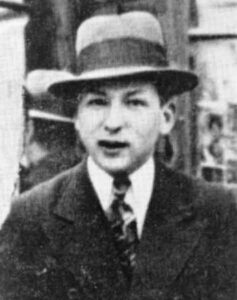Leon (Lejb) “Arie” Rodal (29.01.1913 – 6.05.1943/27.04.1943)
Journalist, commander of the Jewish Military Union, hero of the Warsaw Ghetto Uprising.
Rodal was born on 29 January 1913, into a respected and well-off Hasidic merchant family in Kielce, where his parents ran a shop. His father Pinchas was a Gur Hasid, this branch of Hasidism is distinguished by its special emphasis on traditional yeshiva-style education. Leon therefore received a traditional religious education in a cheder, and simultaneously studied in a primary school and a Polish high school. Nothing is known where he studied, though. His mother Ester is remembered as an exceptional figure, known in the city for her acts of charity, helping those in need and devoted to public work.
He is described in Israeli sources as “a brilliant man with a zealous, devoted Hasidic soul”. A talented writer, became a journalist at a young age, and in the 1930s collaborated with dailies published in Yiddish in Poland – “Der Moment’, “Die Tat”, “Express”. Some post-war publications suggest that Rodal also collaborated with the American dailies “Der Tag” and “Forverts”, for which he was supposed to have written reports on the pogrom in Przytyk, where on March 8, 1936 there were clashes between the Polish and Jewish populations as a result of anti-Semitic agitation. Rodal also intervened as part of a two-person journalistic delegation to the head of the provincial security department, asking for an increase in the police station on the eve of the outbreak of riots in Przytyk.
As a teenager, Rodal joined the Association of Young Revisionist Zionists “Masada” and then Betar – a pre-war Jewish national movement associated with Revisionist Zionism. Zeev Jabotinsky was a founder of Revisionism, and Betar’s goal was to shape a “new Jew” – a pioneer, and prepare young Jews for aliyah to Palestine. Betar offered its members semi-military training for this purpose and advocated the establishment of a Jewish military organization. Rodal became the chairman of the Betar branch in Kielce.
He came to Warsaw before the war, wanting to develop his journalistic career, but we do not know exactly when. Upon hearing of the outbreak of war, he went to Lviv, but returned to Warsaw in 1940. Thanks to the combination of political analysis skills, journalistic talent and dedication, he quickly found himself at the center of the Betar movement’s activities in Warsaw, and in 1942 played a key role in the establishment of the Jewish Military Union in the ghetto.
During the war, Rodal was the driving force behind all of Betar’s publications – he wrote articles, edited most of them, and also dealt with the technical side of the publications. He was the author of texts that appeared in the conspiratorial publications of the revisionists from the time of German occupation – “Ha-Medina” (The State) and “Magen Dawid” (The Star of David). In the latter, Rodal wrote:
“A mortal enemy has arisen and wants to destroy us […] The sign of the Star of David on the Jewish shoulder has become a sign of “victim” for murderers. Powerless and helpless, we stand in the face of a wave of barbarity and animal hatred. However, this sign will not remain in disgrace forever. It will not be a sign of the degraded and tortured for long. Also the hero Goliath fell at the hand of a weak Jew in the shadow of the armor with the Star of David!”.
Due to his extensive contacts, both in the Hasidic world and in the non-revisionist Zionist movement, Rodal played the role of a negotiator and diplomat for the movement. He was also a member of the committee that was supposed to take care of the members of the movement remaining in Warsaw and be responsible for contacts abroad.

fot. Public Domain
Perec Laskier, a member of the Betar command, recalled his colleague Lejb as follows: “He was a practical man, like a seasoned Jewish merchant, he also had the intelligence of a Talmudic scholar. He was able to analyze events and situations and draw conclusions; he was liked among his friends and strangers. He knew how to win people over, even among his opponents. This trait often helped him and his movement in difficult times and moments of crisis. Above all, however, he was characterized by innate enthusiasm, boundless enthusiasm for the Jewish national idea, faith in the Jewish nation and unwavering loyalty to Jabotinsky’s movement.”
In the ghetto, Rodal participated in Betar meetings in 1940, where the need to establish an underground military organization was discussed, which was not implemented. Due to the lack of reliable documents, we do not know the exact date of the establishment of the Jewish Military Union (ZZW) – the largest combat organization in the ghetto, next to the Jewish Combat Organization (ŻOB). It probably happened in the autumn of 1942. The organization was joined by activists from right-wing Zionist formations: Betar, Masada, Irgun. Attempts were made to unite ZZW and ZOB, but due to too many ideological differences, they were not successful and both organizations prepared to fight the Germans separately, although during the ghetto uprising they coordinated their activities.
According to Emanuel Ringelblum, the ZZW had two leaders: Paweł Frenkel and Lejb Rodal. According to other sources, the main leader was Frenkel, and Rodal was his deputy. There is no doubt that Lejb Rodal was one of the commanders of the ŻZW. He was involved in, among other things, purchasing weapons and smuggling them into the ghetto. In Eugenia Banach’s account, we read: “My husband and I had weapons and ammunition, buried in 1939 when the Polish army abandoned them during the escape […] We sold these weapons and ammunition at an organizational price to a certain Rodal in the ghetto. The weapons that they bought from me were carried in bread […] A certain Rodal from Kielce, there were two of them – brothers. They were very brave, they were involved in delivering weapons to the ghetto.” Lejb’s brother – Abram Rodal, was also involved in activities in the ZZW.
During the ghetto uprising, the Jewish Military Union fought mainly in the central ghetto, in the area of Muranowska Street. We still do not have detailed knowledge about what exactly happened during the fights at Muranowski Square. Due to the fact that practically none of the ZZW members survived the war, information about the ZZW is fragmentary and was manipulated after the war. Mostly information about the course of the fights involving ZZW fighters can be found in the testimony of Jurgen Stropp – the German commandant. In any case, the confrontation in the area of Muranowski Square began on April 19, 1943, ZZW fighters numbering about 150 people fought fierce battles there with much larger Nazi units. Initially, the Germans were surprised by the resistance of the Jews equipped with, among other things, two machine guns and several rifles. After several hours of fighting, the Germans withdrew. ŻZW fighters hung two banners on one of the buildings adjacent to the square: a white-red Polish one and a white-blue Jewish one, clearly visible outside the ghetto walls, which became one of the symbols of the uprising.
The fighting at the square lasted 3 days. On April 22, after a massive attack by the Germans using tanks on the square, about 120 ZZW fighters withdrew from the ghetto through a tunnel running under the ghetto wall from the basement of the tenement house at Muranowska 7. This tunnel was prepared long before the start of the uprising. It was used to smuggle weapons into the ghetto, and it was also planned to be used as an evacuation route from the closed district.
Almost none of them survived. Most were murdered by the Germans in hideouts on the Aryan side in the first days after leaving the ghetto. From that moment on, the fate and details of the deaths of ZZW leaders have been a kind of mystery.
Leon Rodal fought heroically in the uprising; according to one account, he was the one who put two banners on the roof of the building. It is not certain, however, how he died, and there are several stories on the subject in the sources. The first one says that Rodal died in the ghetto on April 20, fighting in defense of two banners. According to other accounts, Leon escaped the ghetto through a tunnel with a group of ZZW members and hid with them in a house at Muranowska 6. This group went towards the village of Michalin, where the fighters rented a villa from a Pole (Cezary Ketling-Szemley). The group arrived there safely, but they were betrayed by a Polish blue policeman and murdered by the Germans. According to this version, Rodal died with other insurgents on April 27. According to another version, the most frequently repeated in recent years, Rodal, who had been hiding for some time after leaving the ghetto in a bunker at Grzybowska 13, set off with several fighters back to the ghetto in order to save Jews who were still in the burning ghetto. On May 5, the first group left the ghetto through a tunnel, but the next day, when the second group was being led out, the fighters and civilians were attacked by Germans and Polish policemen. According to this version of events, Leon Rodal died trying to save people, and the date of May 6, 1943 is considered the probable date of his death.
In 2023, Leon “Arie” Rodal was posthumously awarded the The Order of Polonia Restituta by the Polish State.
Reference list:
- Mosze Arens, Flagi nad Gettem Rzecz o Powstaniu w Getcie Warszawskim, Kraków 2011
- Dariusz Libionka, Laurence Weinbaum, Bohaterowie, hochsztaplerzy, opisywacze. Wokół Żydowskiego Związku Wojskowego, Warszawa 2012
- Lazar-Litai Chaim, Mecada szel Warsza ha-Irgun ha-Cwai be-mered be-getto Warsza [Warszawska Masada — Związek Wojskowy w powstaniu w getcie warszawskim], Tel Awiw 1963.
- Archiwum Ringelbluma, Tom 20, Dok 3.
- AŻIH, Relacja Eugenii Banach, 301/5116
- Archiwum GFH, Machon Zabotinski Be-Israel, 161346
- Sprawozdanie Scenograficzne z posiedzenia 11 posiedzenia Senatu 1936, przemówienie Mojżesza Shorra

